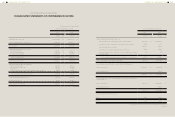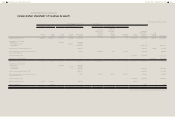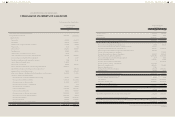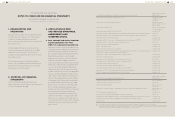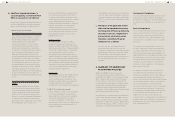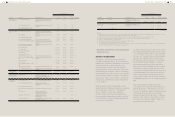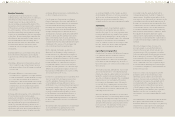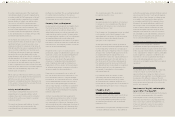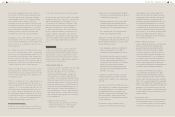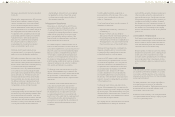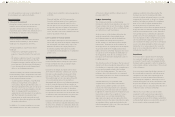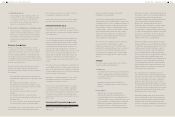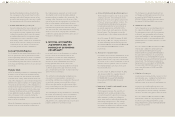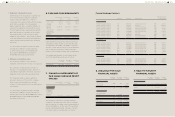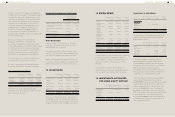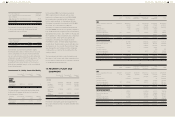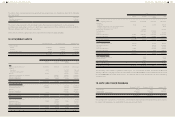HTC 2013 Annual Report Download - page 132
Download and view the complete annual report
Please find page 132 of the 2013 HTC annual report below. You can navigate through the pages in the report by either clicking on the pages listed below, or by using the keyword search tool below to find specific information within the annual report.
FINANCIAL INFORMATION FINANCIAL INFORMATION
260 261
extent of the impairment loss, if any. When it is
not possible to estimate the recoverable amount
of an individual asset, the Company estimates
the recoverable amount of the cash-generating
unit to which the asset belongs. When a
reasonable and consistent basis of allocation can
be identified, corporate assets are also allocated
to individual cash-generating units, or otherwise
they are allocated to the smallest group of cash-
generating units for which a reasonable and
consistent allocation basis can be identified.
Intangible assets with indefinite useful lives
and intangible assets not yet available for use
are tested for impairment at least annually, and
whenever there is an indication that the asset
may be impaired.
Recoverable amount is the higher of fair value
less costs to sell and value in use. In assessing
value in use, the estimated future cash flows are
discounted to their present value using a pre-
tax discount rate that reflects current market
assessments of the time value of money and the
risks specific to the asset for which the estimates
of future cash flows have not been adjusted.
If the recoverable amount of an asset (or cash-
generating unit) is estimated to be less than its
carrying amount, the carrying amount of the
asset (or cash-generating unit) is reduced to its
recoverable amount.
When a n impair m e n t loss s ubseque n t l y is
reversed, the carrying amount of the asset or a
cash-generating unit is increased to the revised
estimate of its recoverable amount, but so
that the increased carrying amount does not
exceed the carrying amount that would have
been determined had no impairment loss been
recognized for the asset (or cash-generating unit)
in prior years. A reversal of an impairment loss is
recognized immediately in profit or loss.
Financial Instruments
Financial assets and financial liabilities are
recognized when a group entity becomes a party
to the contractual provisions of the instruments.
Financial assets and financial liabilities are initially
measured at fair value. Transaction costs that are
directly attributable to the acquisition or issue
of financial assets and financial liabilities (other
than financial assets and financial liabilities at
fair value through profit or loss) are added to
or deducted from the fair value of the financial
assets or financial liabilities, as appropriate, on
initial recognition. Transaction costs directly
attributable to the acquisition of financial assets
or financial liabilities at fair value through profit
or loss are recognized immediately in profit or
loss.
Financial assets
All regular way purchases or sales of financial
assets are recognized and derecognized on a
trade date basis/settlement date basis. Regular
way purchases or sales are purchases or sales
of financial assets that require delivery of assets
within the time frame established by regulation or
convention in the marketplace.
a. Measurement category
Financial assets are classified into the following
specified categories: Financial assets at
fair value through profit or loss ("FVTPL"),
held-to-maturity investments, available-for-
sale financial assets ("AFS") and loans and
receivables. The classification depends on the
nature and purpose of the financial assets and
is determined at the time of initial recognition.
All regular way purchases or sales of financial
assets are recognized and derecognized on a
trade date basis. Regular way purchases or
sales are purchases or sales of financial assets
that require delivery of assets within the time
frame established by regulation or convention
in the marketplace.
1. Financial assets at FVTPL
Financial assets are classified as at FVTPL
when the financial asset is either held for
trading or it is designated as at FVTPL.
A financial asset is classified as held for trading if:
‧ It has been acquired principally for the purpose
of selling it in the near term; or
‧ On initial recognition it is part of a portfolio
of identified financial instruments that the
Company manages together and has a recent
actual pattern of short-term profit-taking; or
‧ It is a derivative that is not designated and
effective as a hedging instrument.
A financial asset other than a financial asset held
for trading may be designated as at FVTPL upon
initial recognition when doing so results in more
relevant information and if:
‧ Such designation eliminates or significantly
reduces a measurement or recognition
inconsistency that would otherwise arise; or
‧ The financial asset forms part of a group of
financial assets or financial liabilities or both,
which is managed and its performance is
evaluated on a fair value basis, in accordance
with the Company's documented risk
management or investment strategy, and
information about the grouping is provided
internally on that basis.
In addition, if a contract contains one or more
embedded derivatives, the entire combined
contract (asset or liability) can be designated as
at FVTPL.
Financial assets at FVTPL are stated at fair value,
with any gains or losses arising on remeasurement
recognized in profit or loss. The net gain or loss
recognized in profit or loss incorporates any
dividend or interest earned on the financial asset
and is included in the 'other gains and losses'
line item. Fair value is determined in the manner
described in Note 32.
Investments in equity instruments under
financial assets at FVTPL that do not have a
listed market price in an active market and
whose fair value cannot be reliably measured
and derivatives that are linked to and must be
settled by delivery of such unquoted equity
instruments are subsequently measured at cost
less any identified impairment loss at the end
of each reporting period and are recognized in
a separate line item as financial assets carried
at cost. The financial assets are remeasured at
fair value if they can be reliably measured at fair
value in a subsequent period. The difference
between the carrying amount and the fair value
is recognized in profit or loss.
2. Held-to-maturity investments
Held-to-maturity investments are non-derivative
financial assets with fixed or determinable
payments and fixed maturity dates that the
Company has the positive intent and ability
to hold to maturity other than those that the
entity upon initial recognition designates as at
fair value through profit or loss, or designates
as available for sale, or meet the definition of
loans and receivables. Corporate bonds above
specific credit ratings and the Company has
positive intent and ability to hold to maturity, are
classified as held-to-maturity investments.
The effective interest method is a method
of calculating the amortized cost of a debt
instrument and of allocating interest income
over the relevant period. The effective interest
rate is the rate that exactly discounts estimated
future cash receipts (including all fees and points
paid or received that form an integral part of the
effective interest rate, transaction costs and other
premiums or discounts) through the expected
life of the debt instrument, or, where appropriate,
a shorter period, to the net carrying amount on
initial recognition.
3. AFS financial assets
AFS financial assets are non-derivatives that are
either designated as AFS or are not classified
as (i) loans and receivables, (ii) held-to-maturity
investments or (iii) financial assets at FVTPL.



